#San Isidro Farm
Text
Mountain View Lot For Sale in Costa Azul Development, Tres Rios, Coronado, Osa ($249,000.00)
Mountain View Lot For Sale in Costa Azul Development, Tres Rios, Coronado, Osa ($249,000.00)
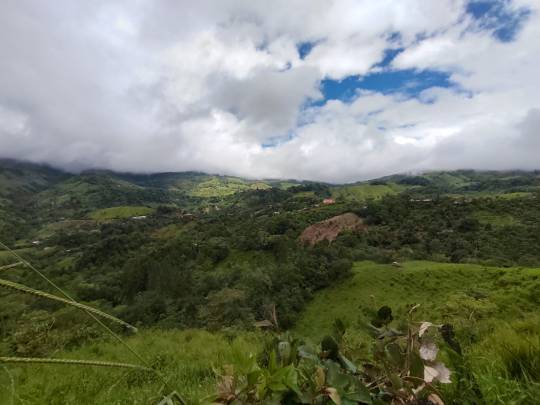
View On WordPress
#Agro Farm#Farm for sale#Listings Costa Rica#Mountain View Farm#Perez Zeledon Farm#Real Estate Costa Rica#San Isidro Farm
0 notes
Text
Reflection: To Be Fruitful, Be Faithful
Various parishes and communities rejoice and celebrate today the Feast of Saint Isidore, patron of farmers. In our province of Bulacan, they continue the tradition of parading carabaos who would kneel—to show their strength, not holiness—in front of the parish church of San Isidro Labrador. There are many stories of Saint Isidore’s deep devotion to the Eucharist as a farmer who lived near Madrid, Spain in the year 1000. If we follow closely the stories about his piety, he was more faithful to the Mass and prayers than with farming.
According to stories, Saint Isidore would never miss the daily early-morning Mass. His fellow farmers knew he was always in church but they wondered how he still had more bountiful harvests than them. When they investigated, they found out that while Saint Isidore was in church, angels would come to do his farm work. Stories about his charities among the poor also abound. One story goes that his wife, Saint Maria Torribia, would always keep a pot of stew or any soup to feed beggars who followed him every afternoon from the farm. The pot had miraculously never ran dry despite their poverty.
Saint Isidore’s stories of piety and charity tell us today that for us to be fruitful in life, we have to be faithful to God. This was also the message of Saint Paul to the leaders of the church in Ephesus before he left them for Rome to face his trial and death. He reminded them of fidelity to the Gospel and the teachings handed down to them because after his departure, “savage wolves will come among you, and they will not spare the flock” (Acts 20:29). It is also a warning to us today. Like Saints Paul and Isidore, let us sincerely proclaim—in word and in deed—our fidelity to Christ and His teachings.
Let us examine the kind of life we live in these trying times, when faith and spirituality are laughed at and even disregarded. The modern forces have long been destroying us, young and old alike, enslaving us and affecting so much the way we see the world and life itself. May we keep in mind how we were consecrated by Jesus Himself to His Father after His Last Supper.
~Fr. Nick F. Lalog
If ever you would die today, what would people remember most about you? Would they speak about your faith and piety?
Lord Jesus, may Your grace give me more fervor for piety and charity. Amen.
Prayer
… for a deep and profound respect for life, especially for the unborn.
… for the strength and healing of the sick.
… for the healing and peace of all families.
Finally, we pray for one another, for those who have asked our prayers and for those who need our prayers the most.
GOD BLESS!
0 notes
Text
Keep Your Dream
I have a friend named Monty Roberts who owns a horse ranch in San Isidro. He has let me use his house to put on fund-raising events to raise money for youth at risk programs.
The last time I was there he introduced me by saying, "I want to tell you why I let Jack use my horse. It all goes back to a story about a young man who was the son of an itinerant horse trainer who would go from stable to stable, race track to race track, farm to farm and ranch to ranch, training horses. As a result, the boy's high school career was continually interrupted. When he was a senior, he was asked to write a paper about what he wanted to be and do when he grew up.
"That night he wrote a seven-page paper describing his goal of someday owning a horse ranch. He wrote about his dream in great detail and he even drew a diagram of a 200-acre ranch, showing the location of all the buildings, the stables and the track. Then he drew a detailed floor plan for a 4,000-square-foot house that would sit on a 200-acre dream ranch.
"He put a great deal of his heart into the project and the next day he handed it in to his teacher. Two days later he received his paper back. On the front page was a large red F with a note that read, `See me after class.'
"The boy with the dream went to see the teacher after class and asked, `Why did I receive an F?'
"The teacher said, `This is an unrealistic dream for a young boy like you. You have no money. You come from an itinerant family. You have no resources. Owning a horse ranch requires a lot of money. You have to buy the land. You have to pay for the original breeding stock and later you'll have to pay large stud fees. There's no way you could ever do it.' Then the teacher added, `If you will rewrite this paper with a more realistic goal, I will reconsider your grade.'
"The boy went home and thought about it long and hard. He asked his father what he should do. His father said, `Look, son, you have to make up your own mind on this. However, I think it is a very important decision for you.' "Finally, after sitting with it for a week, the boy turned in the same paper, making no changes at all.
He stated, "You can keep the F and I'll keep my dream."
Monty then turned to the assembled group and said, "I tell you this story because you are sitting in my 4,000-square-foot house in the middle of my 200-acre horse ranch. I still have that school paper framed over the fireplace." He added, "The best part of the story is that two summers ago that same schoolteacher brought 30 kids to camp out on my ranch for a week." When the teacher was leaving, he said, "Look, Monty, I can tell you this now. When I was your teacher, I was something of a dream stealer. During those years I stole a lot of kids' dreams. Fortunately you had enough gumption not to give up on yours."
Moral: Don't let anyone steal your dreams. Follow your heart, no matter what. No Dream is too big or too small when one works hard to live it. One should always try making dreams come true no matter what.
🅰️ryan
#storytelling#stories#storia#short story#story#english story#english#inspiration story#inspiring words#inspiring quotes#inspiring beauty#inspiration#life#morning#india
1 note
·
View note
Text
"Discovering the Charm and Rich Heritage of Mabini, Davao De Oro".
Literary Journalism
Mabini, a small town in the province of Davao De Oro, exudes a certain charm that is unique to rural communities. As one travels along the winding roads leading to the town proper, the lush greenery and the fresh air provide a welcome respite from the hustle and bustle of the city. The people in Mabini are warm and friendly, always greeting visitors with a smile and a helping hand.
The town of Mabini is named after the Philippine hero Apolinario Mabini, who played a significant role in the country's struggle for independence from Spanish colonial rule. Mabini, also known as the "Sublime Paralytic," was a brilliant political philosopher and a trusted adviser to the revolutionary leader, General Emilio Aguinaldo.
Today, Mabini remains a quiet, unassuming town, with a population of around 20,000. The town's main source of livelihood is farming, with rice, corn, and coconut as the primary crops. The town also has a thriving fishing industry, with its residents taking advantage of the rich marine resources of nearby Davao Gulf.
One of the town's notable attractions is the Mabini Nature Park, a 12-hectare park located on a hill overlooking the town. The park features a butterfly garden, a bird sanctuary, and a jungle trail that leads to a breathtaking view of the surrounding mountains and the sea. The park is also home to the Mabini Nature and Science Center, where visitors can learn more about the town's flora and fauna.
Mabini also has a rich cultural heritage, with its residents preserving the traditions and customs of their ancestors. The town celebrates its annual fiesta in honor of its patron saint, San Isidro Labrador, with a colorful procession, street dancing, and a grand feast.
Despite its small size, Mabini has produced several notable personalities who have made significant contributions to the country. One of them is the late Congressman Prospero Nograles, who served as the Speaker of the House of Representatives from 2008 to 2010.
Mabini may be a small town, but it is a testament to the resilience and strength of the Filipino spirit. Its people, with their hard work and determination, have built a community that is rich in culture, history, and natural beauty. For those who seek a peaceful respite from the chaos and noise of the city, Mabini is a hidden gem waiting to be discovered.
1 note
·
View note
Text

This year, because of constraints imposed by ******* I am only planting the heirloom tomatoes (Hartmann's yellow gooseberry) and bush beans (from my old boss's garden) I saved from last year's vegetables. What grows and I can't plant or give away to friends I will make as an offering to San Isidro, who protects farm workers.
0 notes
Link
This Property, for sale in the Southern Costa Rica real estate market is currently producing an income from natural produce grown organic coffee right on this property! Start your permaculture dream escape on this fertile tract of land.
This 29 acres farm is located just 30 minutes from n San Isidro del General, away from the usual tourist destinations in this region, and still only a 1-mile drive from the main highway. Feel remote and private while still having easy access to and from local amenities and attractions.
0 notes
Text
Month of August is History Month
Every year, the month of August is declared as History Month pursuant to Proclamation No. 339 signed by former President Benigno Simeon Aquino III on February 16, 2012. This year, the National Historical Commission of the Philippines (NHCP) announced that the theme of the celebration is: "Kasaysayan, Kamalayan, Kaunlaran" (History, Consciousness, Development).
The NHCP encourages all government agencies, educational institutions and other organizations to conduct activities in line with the celebration of History Month.
Relative thereto, I am presenting to you the list of Barangay Captains (previously termed as Teniente del Barrio) of Barangay Cebulano who really contributed to the development of the community through their painstaking sacrifices. May their legacies will inspire us to look back at history by learning its lessons as a vehicle in achieving our desired social and economic development.
The following hold the position as Barangay Captain of Barangay Cebulano, Carmen, Davao del Norte, to wit:
1. Hon. Felomino M. Cejas - no photo available
2. Hon. Gaudencio M. Jalop
3. Hon. Lope S. Roferos
4. Hon. Pedro D. Cafe
5. Hon. Miguel V. Arcilla
6. Hon. Custodio D. Cafe, Sr.
7. Hon. Edwin N. Galaura, Sr.
8. Hon. Cornelio C. Adaya
Brief History of Barangay Cebulano
Sometime in 1941, when Cebulano was yet a place with no name, Atty. Juan Sarenas and Pastor Benito Israel through the request of the Japanese armies presided a forum for the constituents, to give their place a name. "CEBULANO", a coined name of Cebuano and Bol-anon, was unanimously approved thru an informal meeting attended by some prominent personalities of the place. To mention few are Eleuterio Orbeta, Ramon Galaura, Pedro Consarva, Felomino M. Cejas, Balbino Bungabong, Sr. and Emilio Dungog.
Felomino M. Cejas, fondly called Minoy, was chosen as their leader and was designated as Secretary by the Japanese Imperial Army stationed in Cebulano. Through the efforts of Felomino M. Cejas, Ramon Galaura and Pedro Consarva, Cebulano Primary School came into existence in 1945 with Leonardo Torres as the first Teacher In-charge. ^
Since the early inhabitants were extensively engaged in farming, they chosen Saint Isidore the Farmer (San Isidro Labrador) as their Patron Saint when a Basic Ecclesial Community (Gagmay'ng Kristohanong Katilingban) was then established in 1947 in Centro Cebulano.
Executive Order No. 236 was signed by President Elpidio R. Quirino on July 1, 1949 creating the Municipality of Panabo detaching from the western portion of the Municipality of Tagum. Barrio Ising, with the sitio of Cebulano, became part of the territorial jurisdiction of Panabo.
In the year 1968, Municipality of Carmen was born in the Province of Davao del Norte thru Republic Act No. 4745 separated from the Municipality of Panabo. Cebulano was taken as one of its barrios.
The Puroks of Barangay Cebulano
1. Purok 1 Loceta - means Lower Cebulano Teamwork Association, a name of a youth organization before that is equivalent to the Diocesan Youth Apostolate (DYA) at present; created during the term of Pedro Cafe and celebrated their Araw ng Purok every 30th day of November since 2013
2. Purok 1A Binangay - created in 2013 during the term of Cornelio Adaya
3. Purok 2 Damoza - formerly called as Bagsak; created during the term of Pedro Cafe
4. Purok 3 Centro - created during the term of Pedro Cafe
5. Purok 3A Centro - created in 2003 during the term of Edwin Galaura, Sr. and celebrated their Araw ng Purok every 25th day of February since 2019
6. Purok 3B Centro - created in 2014 during the term of Cornelio Adaya
7. Purok 4 Boundary - created during the term of Pedro Cafe
8. Purok 5 Kalubian - created during the term of Miguel Arcilla
9. Purok 6 Mangga - created during the term of Lope Roferos and celebrated their Araw ng Purok every 1st day of March since 2000
10. Purok 7 Malinao - created during the term of Miguel Arcilla
__________________________
^ Based on the research conducted by Mrs. Aurelia I. Cuarenta, former Head Teacher III of Cebulano Elementary School and wife of former Municipal Mayor of Carmen, Hon. Gonzalo O. Cuarenta, Sr.
#HistoryMonth
#BuwanNgKasaysayan
#KasaysayanKamalayanKaunlaran
#ProclamationNumber339
#BarangayCebulano
#FelominoCejas
#GaudencioJalop
#LopeRoferos
#PedroCafe
#MiguelArcilla
#CustodioCafeSr
#EdwinGalauraSr
#CornelioAdaya
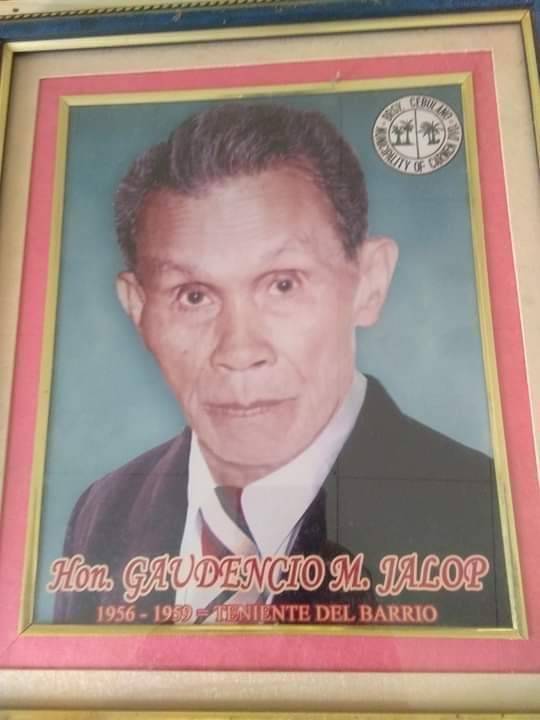
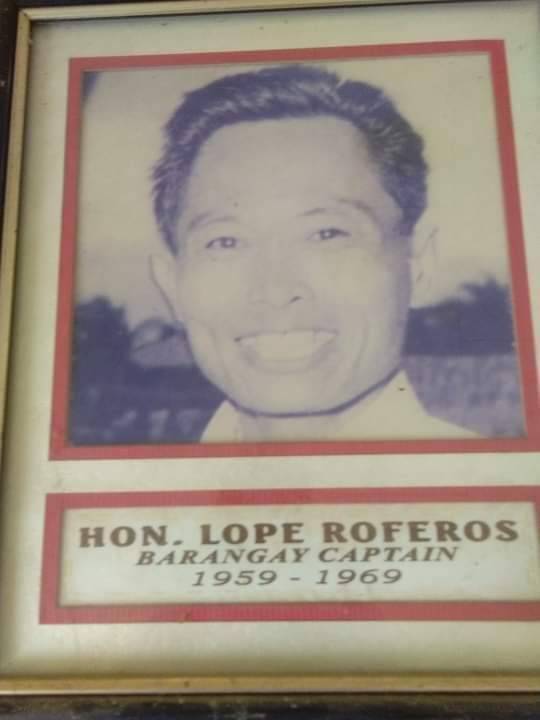

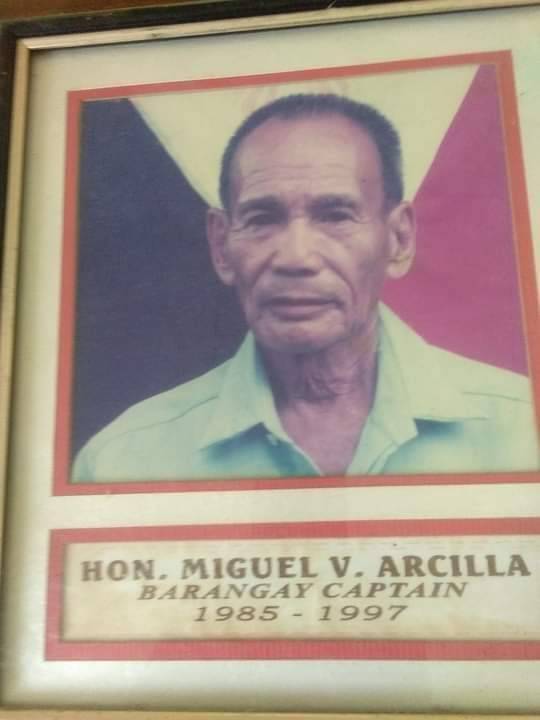

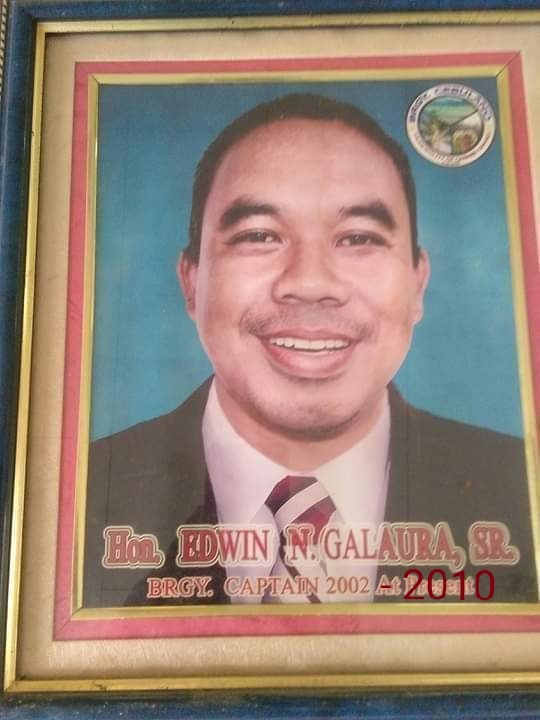

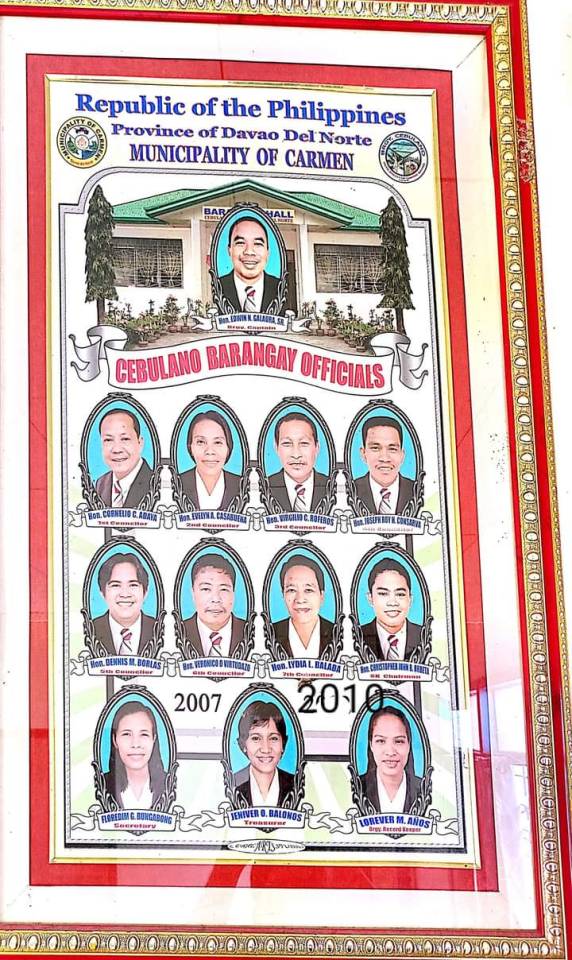
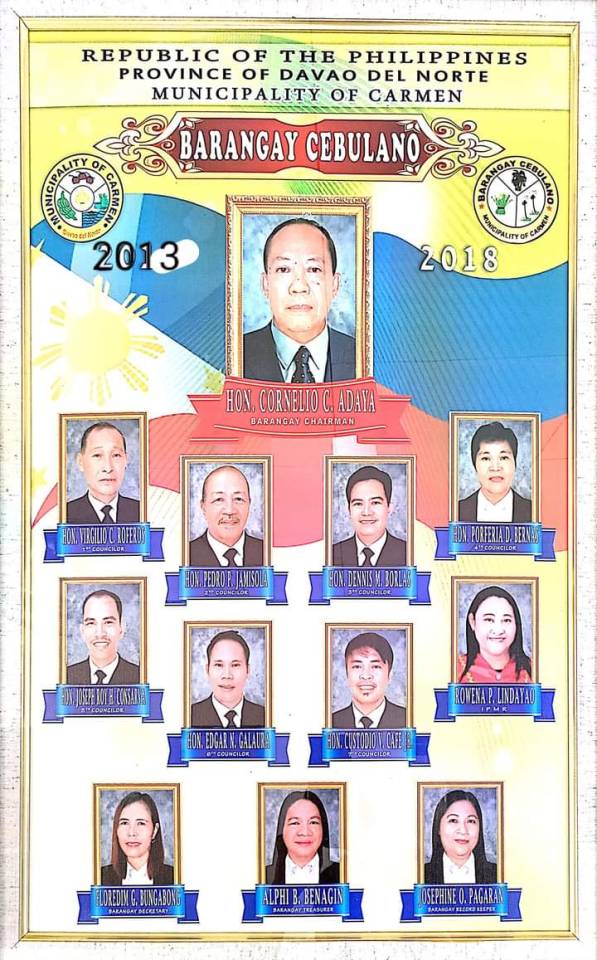
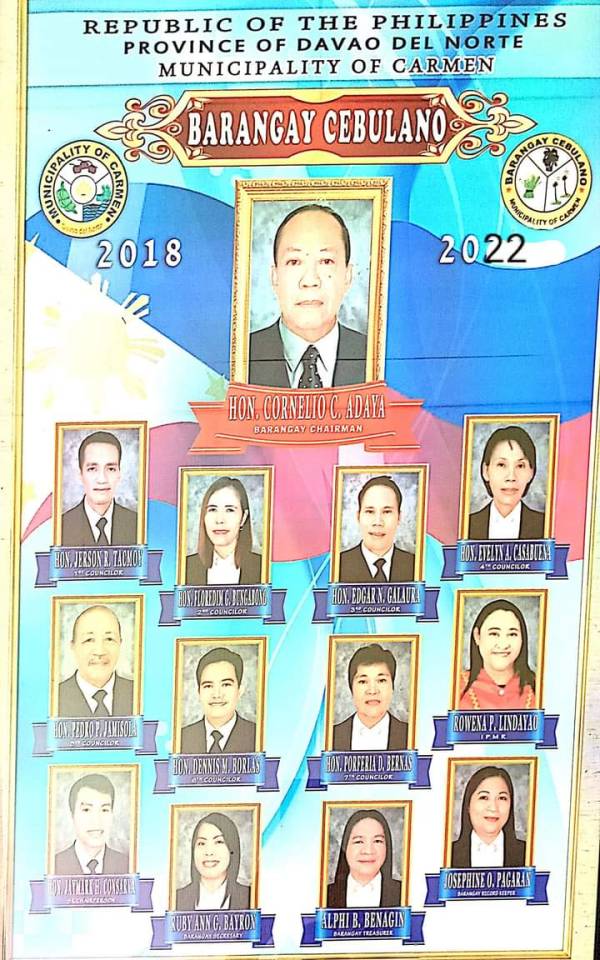
1 note
·
View note
Text
Food and Ghosts in Peru ...
And certainly, I never planned to write a book that critiqued the chefs credited for transforming Peru -- the country of my birth -- from a place of terror, violence and poverty, to a vibrant, global culinary destination. But as I conducted research for a different project in the early 2000s, it became clear that Peru’s so-called “gastronomic revolution” was central to any contemporary exploration of culture, politics and coloniality in this Andean nation. I was especially intrigued by the ways particular histories of violence haunted hegemonic narratives of inclusion, racial harmony, and economic success, all made possible (as the story goes) through the rediscovery and revalorization of Peruvian cuisine.
As I write in Gastropolitics and the Specter of Race, backstories of violence matter. After over two decades of political violence that claimed at least tens of thousands of lives, not to mention the countless lives destroyed by kidnapping, torture, displacement, sexual violence, and more, the argument made forcefully by prominent chefs in the capital city of Lima is seductive. They claim that gastronomy can offer a path to economic opportunity and support Indigenous livelihoods through chef-producer alliances that make possible farm to table dining. Culinary festivals can showcase cultural vibrancy, biodiversity, and indigeneity to the world, and help Peruvians rediscover and fall in love with their country. In short, Peruvian food and the country’s culinary history of racial, cultural fusion have the power to unite and to heal.
But a closer look at these narratives and practices, at high-end menus and well-meaning chefs, and at the gastropolitical machine that became central to national projects of restoration as the country transitioned to “peace” and democracy, reveals a darker side.
Gastronomy in Peru is implicated with ongoing forms of violence -- colonial and otherwise.
Colonialism shape-shifts.
Its Peruvian echoes and forms can be felt in multiple ways through gastropolitics. At times, writing and researching this book felt like thinking with ghosts. I remember two moments in particular, which both took place in Astrid & Gastón, the flagship restaurant of Gastón Acurio. Acurio is one of the architects of Peru’s gastronomic revolution, and perhaps the leading chef and culinary spokesperson in the country.
-------
The first moment was during my initial visit to the restaurant, located in a restored Casa Moreyra, the 300-year-old main house of the old hacienda in San Isidro, one of the most affluent districts in Lima. We were seated next to a painting called “historia de un huaquero afortunado” by Cuban artist Jose Bedia. As I looked at that remarkable painting [...] I suddenly knew my project had shifted. Huaqueros are looters, persons who clandestinely excavate archaeological sites in order to find pre-Hispanic artefacts to sell illegally, usually to foreign collectors. Huaca means sacred in Quechua, and often refers to sacred objects and places. The painting depicts a figure at the top of a mound, with a clear path leading to a huaca, drawn as a simple white triangular outline with a small, round face. The huaquero is fortunate as he has found his treasure. To me the painting spoke to the extractive and appropriative dimensions of the Peruvian gastronomic revolution. It brought to mind in particular the ongoing theft of Indigenous lands, sacred objects, and intellectual property. But the painting also evoked the Huaca Huallamarca, a striking pyramidal mound located only a few blocks from Astrid & Gastón. When I visited that Huaca during my last trip to Peru in January 2020, I thought back to that painting. Rather than see only the commodification of this space, I felt a powerful refusal to be swallowed up. Could the Huaca not stand instead as a testament to the survivance of Indigenous peoples?
-------
The second moment took place during my last visit to Astrid & Gastón, while on a brief tour of Casa Moreyra. Hoping to learn about how (or if) restaurant staff narrated the histories of violence intimately entangled with an hacienda economy -- one that involved the importation of wheat from Chile, cacao from Guayaquil, indigo from Guatemala, and slaves from Panama -- I asked about the catacombs under the building. As soon as I mentioned them, our guide shook her head:
“Oh no. We don’t go in there. One of my colleagues heard screams coming from there, the screams of a little girl.” I asked how they knew it was a girl. “We saw her,” she whispered.
Ghosts, whether emanating from paintings or buildings, embedded in landscapes, or lurking in the midst of cultural performances at culinary festivals, invite us to reconsider gastropolitics and its multiple impacts. Eve Tuck and C. Ree write that haunting does not “hope for reconciliation. Haunting lies precisely in its refusal to stop…. For ghosts, the haunting is the resolving, it is not what needs to be resolved.”
In Peru, we need ghosts to continue their work. In a context where so many want to forget the violence of the past and refuse to see the ways that violence lingers powerfully in the lives of so many, ghosts can offer productive disruptions. [...] The victims of the political violence of the last century and the pandemic of the current one will haunt Peruvian society for many years to come, as the drastic and obscene inequalities that produced them show no signs of abatement.
-------
Text by: Maria Elena Garcia. “Food and Ghosts in Peru.” UC Press Blog (University of California Press). 25 May 2021.
172 notes
·
View notes
Text
Saint Isidore of Madrid Confessor
(† 1170)
.
Patronage: Madrid, agricultures; farmers; day labourers; San Isidro, Cuz Cuz, Carampa and Lima
.
Saint Isidore the Farmer, a perennially popular Saint in Spain, was born near Madrid of very poor but very Christian parents, who early inspired in him love for God and horror of sin. His education was accomplished entirely by the Holy Spirit who taught him, without books, the science of salvation.
.
He married a wife rich in virtue, Maria Torribia, and God blessed them with a son whom they brought up in the sentiments of their own piety. The child fell into a well, which is still shown in Madrid, and drowned; but when his parents prayed he might be returned to them, the water rose to ground level and brought up the child full of life and health. They promised then to separate, apparently out of gratitude to God, and to live in perpetual continence.
.
Saint Isidore's wife became a hermit like himself; Maria, too, performed miracles and merited after her death the name of Santa Maria de la Cabeza, meaning Head, because her head, conserved in a reliquary and carried in procession, has often brought down rain from heaven for the afflicted countryside. Her remains are honored by all of Spain by pilgrimages and processions at Torrelaguna, where they were transferred in 1615.
.
Saint Isidore himself was a day-laborer on a farm near Madrid, but every day found him at Mass in one of the churches of the city before he set out for his daily task. His employer desired to verify whether he was wasting time during his work, and one day saw two mysterious personages helping the holy worker to guide his plow; Isidore himself told him they were Angels. Afterwards the wealthy owner became still more convinced that piety was useful in all occupations. For not only did his worker bring back to life one of his horses, which he very much needed; when his daughter, too, died, she was resurrected by the Saint. A fountain of water which the Saint caused to surge up by striking the ground still exists.
.
Saint Isidore, though poor, shared all he had with the poor; and one day, when no provisions were left, his cupboard was found well furnished when still another beggar arrived.
.
Saint Isidore died some time after his wife; and forty years later his remains, which had been in extremely wet ground, were found incorrupt. They were taken into the Church of Saint Andrew and re-interred there; miracles have been countless, and celestial music has often been heard at his tomb. He has protected the city of Seville, making himself visible occasionally; and the kings of Spain themselves urged his canonization, which was carried out in 1622 by Pope Gregory XV.
.
Prayer to Venerate Any Saint
.
Saint Isidore of Madrid: Feast Day May 10
.
I desire therefore, first of all, that supplications, prayers, intercessions, and thanksgivings be made for all men: For kings, and for all that are in high station: that we may lead a quiet and a peaceable life in all piety and chastity. For this is good and acceptable in the sight of God our Saviour, Who will have all men to be saved, and to come to the knowledge of the truth. (1 Timothy 2:1-4)
.
And another angel came, and stood before the altar, having a golden censer; and there was given to him much incense, that he should offer of the prayers of all saints upon the golden altar, which is before the throne of God. And the smoke of the incense of the prayers of the saints ascended up before God from the hand of the angel. (Rev. 8:3-4)
.
ETERNAL Father, I wish to honor St. (Name), and I give You thanks for all the graces You have bestowed upon him (her). I ask You to please increase grace in my soul through the merits of this saint, and I commit the end of my life to him (her) by this special prayer, so that by virtue of Your goodness and promise, St. (Name) might be my advocate and provide whatever is needed at that hour. Amen.
.
PROMISE: "When you wish to honor any particular saint and give Me thanks for all the graces I have bestowed on that saint, I increase grace in your soul through the merits of that saint. When you commit the end of your life to any of the saints by special prayers, I appoint those saints to be your advocates and to provide whatever you need at that hour."-Our Lord to St. Gertrude
.
Blessed Anne Catherine Emmerich revealed in her Visions that saints are particularly powerful on their feast days and should be invoked then.
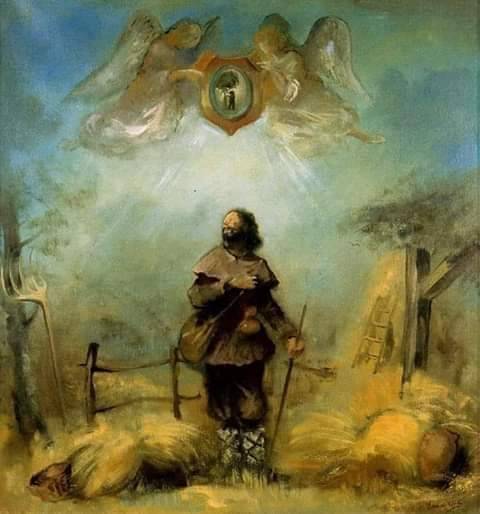
#catholicism#traditional catholic#catholic#heaven#christianity#love#its the truth#jesus christ#catholic saints#catholic faith#saint Isidore
4 notes
·
View notes
Text
Buy farm Costa Rica
Buy farm Costa Rica: This farm property is located in a prime location north of San Carlos in the region of Los Chiles. The farm has easy access to the main road which goes from Muelle to Los Chiles and onwards into Nicaragua.
This pineapple farm provides a high return on investment. With a high percentage of agricultural land (60%) is it a solid and secure investment. This agricultural farm has 67 ha of land for sale. Buy a farm in Costa Rica which is probably the best post-Covid-19 business opportunity in Costa Rica.
The Costa Rica real estate market is very diverse from mountain properties, or land with teak trees villas with beautiful views over the sea. These are great as recreational retreats however, for a real business opportunity, which actual and proven sales, this pineapple farm has it all. Buy farm Costa Rica consist of 67 ha of land of which 40 ha are suitable for mechanized crops such as pineapples. This teak farm for sale is right on the main road, with no need of travelling on gravel roads. v
Other buy farm Costa Rica farms include the fruit trees farms in San Isidro some have river frontage for easy irrigation. Buy farm Costa Rica is the most sensible decision that one can make right now, post covid 19. It will provide any family with a very comfortable way of living. With ROI’s in the region of 15-18% per year up to 26% per year, one will be able to increase the production level from 20 ha to 40 ha. https://buymyfarm.co/
Buy farm Costa Rica is located about 40 min away from the touristic area for Lake Arena / Fortuna and about 3h away from Golf Dulce. Many commercial properties are also available in these regions or development land however, these only provide a positive balance sheet 6-7 months a year during the touristic season. The Golfo Dulce, or Sweet Gulf, sits between the Osa Peninsula and Costa Rica's southern Pacific coastline
Development land is another possibility, but this requires that you have a niche product to sell as most towns already have the required facilities from Hotels and guest houses to small cafés and shops. Many people also look to purchase farms near Playas Del Coco so that they can relax in the wonderful coastal weather. However, these farms seldom have a viable income and are only used as retreats. https://buymyfarm.co/
1 note
·
View note
Text
Buy farm Costa Rica
The easy access to this large farm is located at the end of the road and is a piece of paradise on this earth. The beautiful farm is a 163-acre farm located in the central valley. It has everything that one can imagine from great jungle patches to cultivable land. https://buymyfarm.co/
There are several flat areas for reforestation and reconstructing something of use. The farm's highest point touches the height of 1100ft, and a two-story home can be built, which will day long, helping in refreshing the soul.
Are you looking for a friendly, safe, and natural place to abode in and earn from farming and agriculture?
Buy farm Costa Rica.
The Guabo River has seven springs erupting. The river flows all year round, giving a chance to hear the beautiful river sound. It's a dream place to live in.
The most beneficial mountain properties have a proper electricity facility all the time. The farm of Platanillo has distant valley views giving spectacular views.
The location of this farm has easy access to everything. All necessities are available in the surrounding towns, so no need to worry about the groceries. The property is located only five minutes away from the beach as well as the main highway.
https://buymyfarm.co/The locals of this area have a very friendly nature, and they will guide you in everything. The farm for sale has a market nearby. It also has a butcher and bakery only a few minutes away.
All restaurants, shops, and markets are 20 minutes away, and if you want to go to another city, then the city of San Isidro, also the largest city in Costa Rica, is 35 minutes away. This is a great weekend getaway for both tourist and Costa Rican ‘s alike
If you want to turn this farm into agricultural land, that won't be an issue, too, as every Thursday, there is a large farmer's market where you can hire farmers for your land and start planting. It's a great deal for the money, so don't miss it
2.Self-sustainable organic farm with seven homes
buy farm costa rica Buy farm Costa Rica for a fantastic price, again in Platanillo. This place also has seven homes that were established in 1996. Moreover, the organic farm has been providing organic products to all the nearby community for more than 20 years, so if you are thinking of a big investment, then this place is for you.
Living a healthy life that is free of chemicals and only eating healthy and organic products, then this farm is an ideal land of choice.
It's great for agriculture as there is abundant rain and sunshine for crops to grow. The elevation of this place makes it an excellent place with tall lush green vegetation and fruit trees. The harvest of all these trees and plantations started 20 years back. From that time, almost 50 varieties of plants have been grown. The owners of this place earn high income through the seasonal harvests.
Other than agriculture, this place has enormous pasture areas for livestock grazing making it a perfect buy farm Costa Rica. There are several freshwater springs, a seasonal river, and many ponds that are stocked with Tilapia. Pure water is abundantly supplied to all the houses and farms. There is also a city supply of water in case there is a water shortage.https://buymyfarm.co/
Solar panels provide electricity all the time. Other farm operations can be easily carried out. This farm has a goat house, a bunny house, a sheep house, a chicken coop, an outdoor rancho, a dry room, a wood-burning oven, and two large greenhouses for seasonal vegetation growing.https://buymyfarm.co/
Buy farm Costa Rica; the best self-sustainable farm is the best opportunity for you.
1 note
·
View note
Text
Buy farm Costa Rica
The Costa Rica real estate market is very diverse from mountain properties, or land with teak trees villas with beautiful views over the sea. These are great as recreational retreats however, for a real business opportunity, which actual and proven sales, this pineapple farm has it all. Buy farm Costa Rica consist of 67 ha of land of which 40 ha are suitable for mechanized crops such as pineapples. This teak farm for sale is right on the main road, with no need of travelling on gravel roads.
Other buy farm Costa Rica farms include the fruit trees farms in San Isidro some have river frontage for easy irrigation. Buy farm Costa Rica is the most sensible decision that one can make right now, post coved 19. It will provide any family with a very comfortable way of living. With ROI’s in the region of 15-18% per year up to 26% per year, one will be able to increase the production level from 20 ha to 40 ha.
Buy farm Costa Rica is located about 40 min away from the touristic area for Lake Arena / Fortuna and about 3h away from Golf Dulce. Many commercial properties are also available in these regions or development land however, these only provide a positive balance sheet 6-7 months a year during the touristic season. The Golf Dulce, or Sweet Gulf, sits between the Osas Peninsula and Costa Rica's southern Pacific coastline
Development land is another possibility, but this requires that you have a niche product to sell as most towns already have the required facilities from Hotels and guest houses to small cafés and shops. Many people also look to purchase farms near Playas Del Coco so that they can relax in the wonderful coastal weather. However, these farms seldom have a viable income and are only used as retreats. visit now :https://buymyfarm.co/
1 note
·
View note
Text
Dominical - February 4th
I peddled past familiar shops and cafes down to the ocean. Immediately feeling the comfort and tranquility of one of my favorite places to be. Dominical is a beach town i used to visit on weekend trips from a farm in the mountains of San Isidro that i used to stay at. Some of my favorite memories were made on this beach. Something about it feels like im home again.

In 2019 i met this couple in Dominical who crafts incredible organic jewelry inspired by the earth & the indigenous people of Peru. I bought a necklace from them, and wore it every day for years until one day not too long ago it busted. Things crumble so that new forms can take over. After my swim i rode through the street & recognized the couple and their crafts. I was incredibly excited to find them here again. I spoke with them for a long time about indigenous teachings, epic adventures, and the art they create together. Their english is better than before, and so is my spanish. I found a piece that i really loved. A sliced nut native to costa rica that is incredibly strong, inlaid with stones of Peru. They were so pleased that i returned at perfect timing to receive another powerful craft from them. I ran to the ocean to bless this necklace with the sea.

I ran to the lifeguard tower and yelled for a friend who i met here a few years ago. A head popped out and instantly we were excited & surprised to see each other again. Benny & his brother Juan Carlos were born in Dominical and spent their life here surfing, lifeguarding, and working in the tourism industry. When i met them a couple years ago we became friends & had so much fun dancing at the rum bar. Benny called his brother, and 5 minutes later Jaun Carlos shows up on a bike with hilarious flip up sunglasses making all sorts of hoots and hollars.
We walked down to the estuary and went fishing. I still had no luck. I’ve learned that if i dont want to carry anything, go fishing. If i want to carry more things, look for rocks and shells! I’ve added some serious weight to my pack with all that i have collected. The rest of the day i slack lined on the beach, drank fresh coconut water, and explored places and memories of the past. Today was emotional for me. Lots of laughing, tears, and apologies. I spent a lot of the day sitting with my emotions and reflecting. The ocean has a lot to say. I decided to continue my journey and leave this place of magic behind. Back to the mountains i go.



Sandwhich of the day



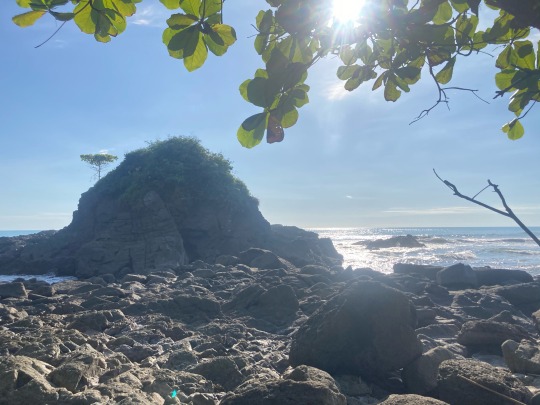
I caught the last bus of the evening to San Isidro with Bikey. I was advised to not bike the road leaving dominical because of the traffic on the tight winding road. It was a short bus ride, and i was ready to be in the mountains. I got to San Isidro just after dark & rode a few miles to an old friend of mine’s apartment. My pal Jerry is someone i met on a farm in Costa Rica who holds a wealth of knowledge & a willingness to share. We stayed up late discussing finance, farming, and just goofing. Jerry taught me something very valuable that night that will stick with me forever. He has been teaching me about this strategy with investing called compounding interest. The way i understand the concept is that when you make an investment you should receive interest on that investment that continously compounds in return. He looked me in the eyes as a man with over 50 years of experiencing the highs and lows, twists and turns, the gains and the losses. He said this, Jeremy, if there is any advice i could ever give you. It is to figure out what it is that brings you happiness and joy. Then ask yourself, does this also bring others joy? Or is it limited to you? By always focusing on making only yourself happy, the radius of joy that spreads is minimal. It gains no interest. By doing something that not only brings you joy, but also to others, the expansion of that joy is infinite. Like compounding interest, when you invest your life into the things that give back, your growth will forever expand. Thank you Jerry, i really needed this. Tomorrow i ride south through the mountains towards San Vito. Only a Few good days of riding before i make it to the farm. Feeling all sorts of excitement.
2 notes
·
View notes
Text
Cebuano News: Plant! Plant! Plant! ubos sa Agusan Up alang sa tuig 2021 nanukad na
#PHinfo: Cebuano News: Plant! Plant! Plant! ubos sa Agusan Up alang sa tuig 2021 nanukad na
DAKBAYAN SA BUTUAN, Enero 13 -- Nanukad ang probinsya sa Agusan del Norte pinaagi sa Team Plant! Plant! Plant! (Team Plant3) sa AGUSAN UP! sa inisyal nga lakang aron makatanum sa siyam ka priority crops sa gipunting nga 3,000 ektaryas sa tuig 2021.
Gihatud sa Team Plant3 ganihang buntag ang inisyal nga 1,000 ka seedling sa abaka alang sa mga mag-uuma ug mga sakop sa Indigenous Peoples (IP) nga andam na’ng motanum sa mga lungsod sa Jabonga ug Santiago.
Ang AGUSAN UP! mao ang kampanya sa pagpalambo sa administrasyon ni Gob. Dale B. Corvera inabagan sa buhatan ni Kongresista Angel Amante-Matba. Ang Plant! Plant! Plant! usa sa mga flagship projects niini.
Ang 3,000 ektaryas nga inisyal nga tamnan ning tuiga kabahin sa 125,000 ektaryas nga gipunting tamnan og abaka, saging, cacao, kape, lubi, bulanghoy, rubber, mangga ug uban pang prutas ug commercial trees hangtud sa tuig 2027.
Usa sa nakadawat sa seedling sa abaka kaganiha mao ang Dinarawan Indigenous Peoples Organization (DIPO) sa lungsod sa Jabonga nga mikomiter og 150 ektaryas nga tamnan og abaca, ingon man sa kape ug cacao hangtud sa tuig 2027.
Ang laing nakadawat og seedlings mao ang Pangaylan Indigenous Peoples Organization (PIPO) nga mikomiter og 200 ektaryas aron tamnan og abaca, kape, rubber ug cassava.
Nakadawat usab ang Kitcharao, Jabonga, Santiago, Tubay Hill Tribe nga mikometer og 300 ektaryas alang sa mga crops nga saging, abaca, ug falcatta sa mga luna nga nahimutang sa lungsod sa Santiago.
Sundan ang pagpanghatud sa seedling sa abaka sa mga mag-uuma ug IPs sa lungsod sa Kitcharao ugma. Himoon usab kini sa uban pang mga lungsod sa mosunod nga mga bulan.
Gawas sa pagpadangat og seedling ipahiluna usab sa AGUSAN UP! nga makamugna ang grupo nga magbarug unya alang sa Abaca Industry Cluster og nursery sa abaca.
Mahinumdoman nga dul-an sa 500 ka mag-uuma ug IPs ang gihatagan sa Team Plant3 og Farm Planning ug Financial Literacy Seminars sugod sa milabay’ng Septiyembre isip kabahin sa pag-andam kanila alang sa pagpananum nga gisugdan niadtong Disyembre.
Magpadayon gihapon ang maong mga seminar samtang magpadayon na ang pagpananum sugod ning bulana ug sa tibuok na’ng tuig.
Dungan niini, gipahiluna usab karon sa Team Process! Process! Process! (Team Process3) ang Abaca Handicraft Processing Village sa Syudad sa Cabadbaran, ang mahimong pasilidades unya sa advance na nga processing activities sa Abaca.
Himoon ang pagpahiluna sa maong processing village samtang pakusgan usab ang suporta sa abaca fiber consolidation ingon man ang ug primary ug pipila ka secondary processing work sa San Isidro United Farmers Multi-Purpose Cooperative (SIUFMULCO).
Ang nahisgutang mga pagpahiluna sa value chain sa abaca kabahin sa nalatid nga roadmap sa mga stakeholders niini nga kab-oton ang kinatibuk-ang halin nga Php2 bilyones pag-abot sa tuig 2027.
Sa maong pagpadangat og seedling mapasalamaton ang mga mag-uuma ug IPs. Sumala pa kang Datu Randy Catarman, Chairman sa DIPO, daku na og ikatabang sa iyang mga membro ang natunol nga mga seedlings sa abaca. Ilang plano nga ibutang ang maong mga seedling sa sa ilang commonal area aron pasanayon ug magsilbing tinubdan na unya sa uban pang saha nga ilang itanum.
Kaabag sa probinsya sa pagpalambo sa abaca industry cluster ang Caraga Office sa Philippine Fiber Development Authority (PhilFida-Caraga) nga nag-produce sa mga seedling nga inisyal nga giapod apod ug iapod-apod pa unya, ingon man ang Agusasn del Norte Office sa Department of Trade and Industry (DTI-Agusan del Norte) nga mikometer na nga mosuporta pagpahiluna sa mga pasilidades nga kinahanglanon unya sa Abaca Processing Village ug ang Baug CARP Multi-Purpose Cooperative nga maoy nagpahulam sa mga mag-uuma ug IPs alang sa kabahin sa mga galastuhan pagtanum og abaka. (Angel Lyn F. Gaviola & Arnfe Flores, Agusan Up, LGU Agusan del Norte/PIA Agusan del Norte)
***
References:
* Philippine Information Agency. "Cebuano News: Plant! Plant! Plant! ubos sa Agusan Up alang sa tuig 2021 nanukad na." Philippine Information Agency. https://pia.gov.ph/news/articles/1063710 (accessed January 13, 2021 at 05:03PM UTC+08).
* Philippine Infornation Agency. "Cebuano News: Plant! Plant! Plant! ubos sa Agusan Up alang sa tuig 2021 nanukad na." Archive Today. https://archive.ph/?run=1&url=https://pia.gov.ph/news/articles/1063710 (archived).
1 note
·
View note
Text
SAN ISIDRO LABRADOR
The other farmhands thought Isidore was lazy, and created extra work for them. Like them, Isidore was a day laborer about a thousand years ago on a wealthy estate in Madrid, Spain. Because before coming to work Isidore took time to go to Mass, the other farmers assumed they were doing some of his share of the work. That they didn't like. They knew nothing that Isidore had any extra support but it wasn't them!
The land owner, Juan de Vargas, went to see what the trouble was all about after he heard his farmhands complain about this praying worker. To his surprise he saw the plow being driven by two angels. If, in Isidore 's absence, the angels did not do all the plowing, they stood next to him and plowed alongside him. In this way, Isidore did more than twice the work he should have on his own, and his work was also being done while at Mass. Juan believed in the miracle he had witnessed, and in his lifetime he would come to see more. He believed that Isidore 's life had saved his daughter. He also thought that Isidore had saved a horse 's life, which was really important for farming.
Whether all these miracles really existed or not, we can't remember. But we know for sure that Isidore was devoted to God profoundly, and taught many others how God is still with us. There was nothing in the way of his praying to God and his worship.
Isidore was born to poor framers close to Madrid in Spain around the year 1070. They loved and served God even though his family was bad. Isidore and his family believed that by helping others, it was necessary to demonstrate love for God. They also gave away what little they had because it was more important for someone else. Isidore had a particular love for the animals. He even cooked them, and took care of them.
Isidore met Maria Torribia, a young woman who loved God profoundly too. They had a son and they married, but the boy died suddenly. Maria and Isidore agreed not to try to have any other kids because they felt they were called to another kind of life by God. They spent their time caring for those in need and praising God, while they still loved each other. Mary became a saint too. In 1130, Isidore died and was canonized in 1622. He and Maria continue to be highly popular in Spain.
The Spanish have a dance that honors Maria and Isidore. They also have processions for their fields and animals that are used to bless them. The Spanish claim that the success of their harvests is very important to these two saints. He is often called St. Isidore the Farmer or St. Isidore the Laborer and is the Patron Saint of Barangay Licuma, Ormoc City, Philippines.
©Saint Resource - saintsresource.com/ isidore-the-farmer
// BLOG POST #1


1 note
·
View note
Text
FOMA 34: Heritage of the Productive Landscape
The lower Segura river valley is located on an old marine sedimentary basin because 2.000 years ago the Mediterranean Sea flooded much of what is now known as the Vega Baja region in South East Spain.
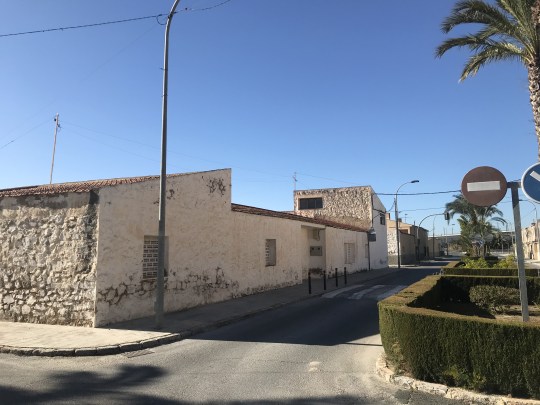
Street profile in San Isidro. | Photo © Carolina Gomez
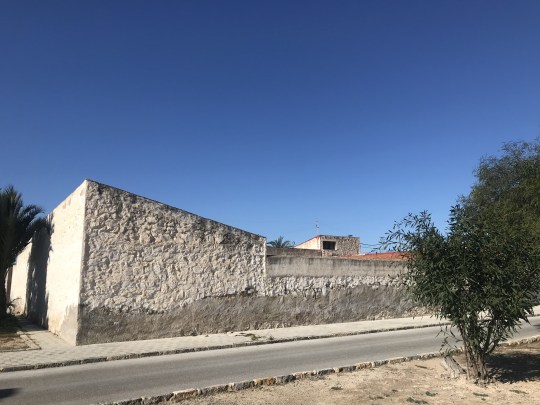
Residential unit and its back courtyard. | Photo © Carolina Gomez
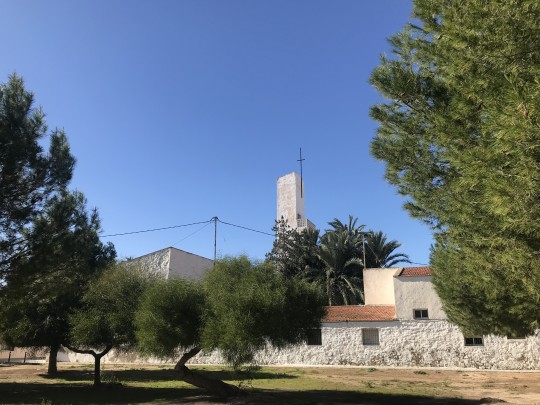
Mix of nature and stone white walls in El Realengo. | Photo © Carolina Gomez
This sedimentary layer is non permeable, so although it rains very seldom (aprox.290,0 mm/year), terrain keeps this water. Combining this particularity with local climate conditions, and its ancient irrigation system, the countryside is very fertile, one of the largest fresh-exporters in Spain.
But lets get back to 1950s in Vega Baja. After the devastation of the Spanish civil war there was the deep need to promote economy, education, and social conditions. National Institute of Rural Development and Colonization was the administrative entity that was established by the Ministry of Agriculture in order to repopulate certain areas of Spain. The Institute acquired land, which it transferred to the villagers under different conditions.
In this scenario Architect Fernandez del Amo, from the institute was developing village planning for Realengo and San Isidro, among others. The objective was to increase agricultural production, meanwhile providing education and housing for workers.

Palm trees field overlays with public buildings. | Photo © Carolina Gomez
Housing units build the plot facade and contain a patio and backyard for planting and farming uses. Following the experimental nature of Fernandez del Amo, each rural development sets main roads and public buildings in the terrain differently. We can find this research also in the way of treating and including landscape and the combination of urban and nature.

The church in El Realengo. | Photo © Carolina Gomez
Making the most of existing resources is the DNA of the place. The architect was working always with local materials and local knowledge, using masonry construction techniques of each area, collaborating with local expertise like cabinet makers, carpenters, mural artists, giving a value to austerity through eliminating superfluous and presenting naked essential architecture, where lines and volumes express abstractly and still follow efficiency and economy.
Urban spaces and the residential complex are all in all, in a good state. Although we miss elements like irrigation system connected with pedestrian paths and other landscape elements, which will allow a complete understanding of the place. Architectural elements as doors, windows, railings, has not always been respected in most of renovation works, that have lead to kitsch solutions.
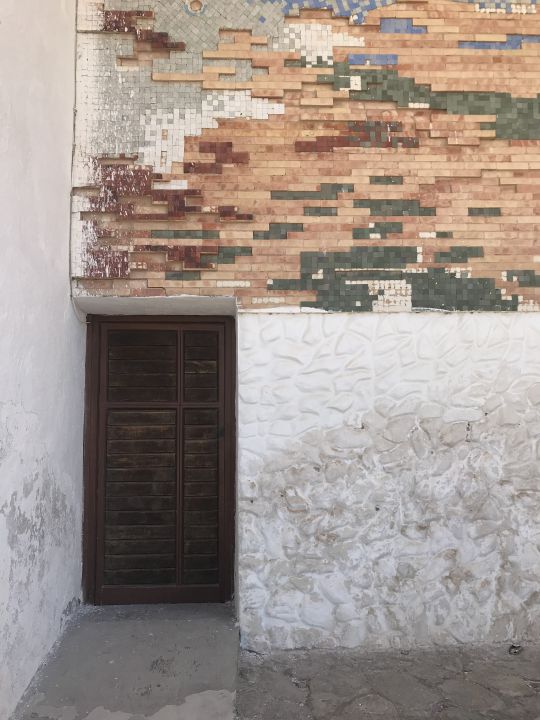
Textures from local masonry, carpentry, mural. | Photo © Carolina Gomez
In an outstanding time, where our way of living and building was evolving, architects like Miguel Fisac, Alejandro De la Sota, Jose Antonio Coderch, and Jose Luis Fernandez del Amo where working with reinterpretation of popular architecture against monumentalism. But how to name it popular architecture, when each step and detail is intellectually extraordinary tailored?
Nowadays, this more authentic postwar architecture concerned with social welfare and austerity connects with climate committed architecture, we are in research. Since 2004, when Rem Koolhaas proclaimed at Columbia University that “preservation is overtaking us”, interest in heritage has grown exponentially. Constructed heritage has expanded to constructed and natural landscapes, infrastructures, and even no-ones lands or in-between spaces. Summing up with climate emergency, we are in the inflexion point where we understand if we are not producing heritage, we are producing waste.

Singular building in San Isidoro. | Photo © Carolina Gomez
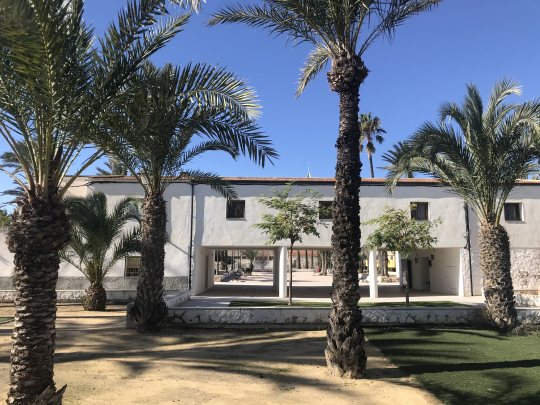
San Isidro main square. | Photo © Carolina Gomez
Lets move to the 60`s in Vega Baja. People were looking for the first time at the coastal line as an attractive place to live in and as a productive landscape (before luxury housing were build in inner fertile areas hiding from the wind and salty atmosphere). Franco's dictatorship exploited sun and beach tourism in Spain through the declaration of National Tourist Interest Areas and Spain was characterized by economic growth.

Dehesa de Campoamor combines different typologies and mix with the existing nature. | Photo © Carolina Gomez
Dehesa de Campoamor was planned as a National Tourist Interest Area by Antonio Orts. It is placed in a singular coastal reddish slope in a landscape of Monte Bajo and Pinada. The project addresses the new demand for summer leisure, experimenting to join functionalist urban planning of the modern movement with the existing nature of the area.
The masterplan research mix of situations: different densities, horizontal and vertical residential typologies and morphologies, radio centric city and garden city, ending up in a rich solution. Masterplan preserves higher environmental quality thanks to the balance between the average density of building and respect for the natural landscape. Lively hood is assured by zoning its main uses and public buildings, especially those related to tourism: yacht club, hotels, restaurants, disco and cinema. We find interesting singular elements as the modern-historical center, the summer cinema, or the yacht Club. Because of all that Dehesa de Campoamor is listed in Docomomo-Ibérico.
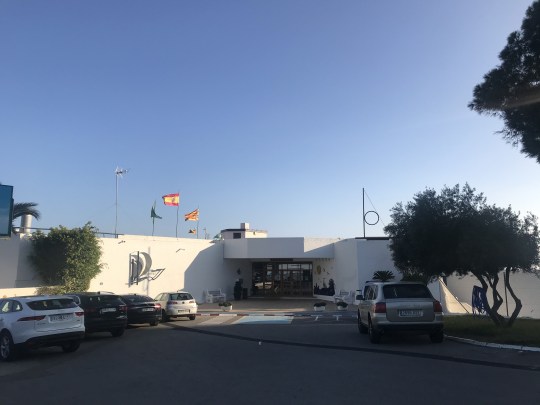
Entrance to Dehesa de Campoamor Yacht Club. | Photo © Carolina Gomez
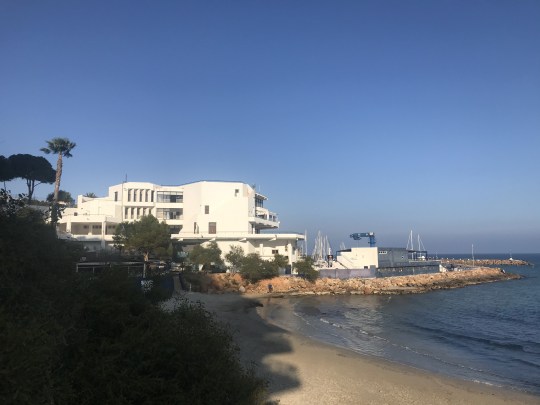
Dehesa de Campoamor Yacht Club from the beach. | Photo © Carolina Gomez
The Yacht Club was developed by Fernández del Amo. The building organises in the steep coastal line based in a hexagonal structure. The architect was familiar working with this shape as he was leading Spanish Brussels Pavillion renovation works with architects Corrales and Vazquez Molezún. The project extract the roots of the popular, attracts and hold the interest in figurative poetics. The building is in a good state and keeps it former uses structure.
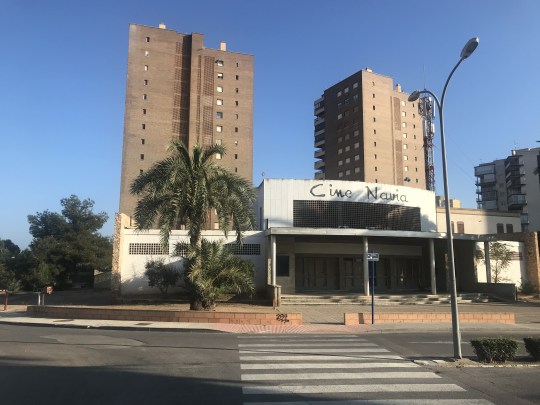
Navia Cinema in Dehesa de Campoamor. | Photo © Carolina Gomez
At the moment of writing this, Countryside, The Future exhibit by Rem Koolhaas and Samir Bantal opens at the Solomon R. Guggenheim Museum in New York. The project presents investigations about the 98% of the earth that is not occupied by cities. Leisure, large scale planning, climate change, migration, ecosystems, preservation. Its time for architects as enablers of the future, to expand their field of vision to countryside, landscape and intermediate spaces.
---
#FOMA 34: Carolina Gómez

Carolina Gómez is an experienced research based strategic urban planner and all-round designer, focusing on landscape, heritage and climate responsive sustainable solutions. Educated as an architect, Carolina has worked independently in urban and landscape design projects of varying scales through Russia, Egypt, and Europe, spanning the fields of analysis, temporary projects, concept visionary design and city transformation projects.
In 2018 she founded Carolina Gómez | Architecture & Environmental Planning in Vega Baja-Spain, where she combines local knowledge with her international experience and strives to build meaningful, context-specific spaces for active and healthy lifestyles, social interaction, sustainable living and exponential technologies.
3 notes
·
View notes